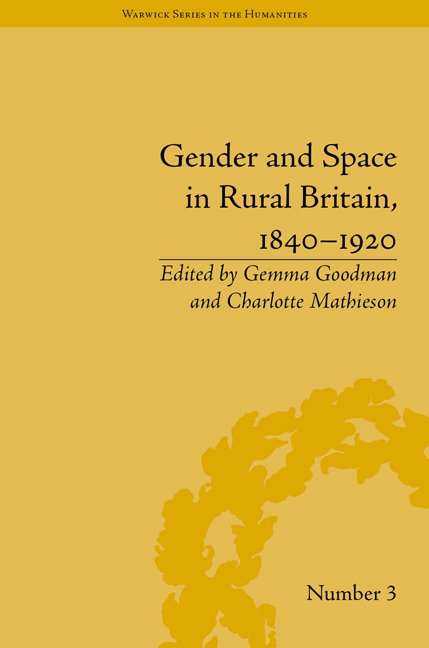Book contents
- Frontmatter
- Contents
- Acknowledgements
- List of Contributors
- Introduction: Gender and Space in Rural Britain, 1840–1920
- 1 Women in the Field
- 2 ‘Between Two Civilizations’: George Sturt's Constructions of Loss and Change in Village Life
- 3 At Work and at Play: Charles Lee's Cynthia in the West
- 4 ‘Going Out, Going Alone’: Modern Subjectivities in Rural Scotland, 1900–21
- 5 ‘Drowned Lands’: Charles Kingsley's Hereward the Wake and the Masculation of the English Fens
- 6 ‘Wandering Like a Wild Thing’: Rurality, Women and Walking in George Eliot's Adam Bede and The Mill on the Floss
- 7 ‘I Never Liked Long Walks’: Gender, Nature and Jane Eyre's Rural Wandering
- 8 Gertrude Jekyll: Cultivating the Gendered Space of the Victorian Garden for Professional Success
- 9 From England to Eden: Gardens, Gender and Knowledge in Virginia Woolf's The Voyage Out
- 10 The Transnational Rural in Alicia Little's My Diary in a Chinese Farm
- Notes
- Index
Introduction: Gender and Space in Rural Britain, 1840–1920
- Frontmatter
- Contents
- Acknowledgements
- List of Contributors
- Introduction: Gender and Space in Rural Britain, 1840–1920
- 1 Women in the Field
- 2 ‘Between Two Civilizations’: George Sturt's Constructions of Loss and Change in Village Life
- 3 At Work and at Play: Charles Lee's Cynthia in the West
- 4 ‘Going Out, Going Alone’: Modern Subjectivities in Rural Scotland, 1900–21
- 5 ‘Drowned Lands’: Charles Kingsley's Hereward the Wake and the Masculation of the English Fens
- 6 ‘Wandering Like a Wild Thing’: Rurality, Women and Walking in George Eliot's Adam Bede and The Mill on the Floss
- 7 ‘I Never Liked Long Walks’: Gender, Nature and Jane Eyre's Rural Wandering
- 8 Gertrude Jekyll: Cultivating the Gendered Space of the Victorian Garden for Professional Success
- 9 From England to Eden: Gardens, Gender and Knowledge in Virginia Woolf's The Voyage Out
- 10 The Transnational Rural in Alicia Little's My Diary in a Chinese Farm
- Notes
- Index
Summary
How little the real characteristics of the working-classes are known to those who are outside them, how little their natural history has been studied, is sufficiently disclosed by our Art as well as by our political and social theories. Where, in our picture exhibitions, shall we find a group of true peasantry? … The notion that peasants are joyous, that the typical moment to represent a man in a smock-frock is when he is cracking a joke and showing a row of sound teeth, that cottage matrons are usually buxom, and village children necessarily rosy and merry, are prejudices difficult to dislodge from the artistic mind, which looks for its subjects into literature instead of life.
George Eliot's words in an 1856 essay on W. H. Riehl's Natural History of German Life provide an indicative starting point for this collection, encapsulating many of the myths and stereotypes that have typically dominated cultural ideas of rurality. Art and literature, Eliot argued, had long depicted a vision of rural life as a world of idyllic ploughmen, buxom maidens and rosy-faced children – a vision, she contended, that was far from the ‘truth of rustic life’: ‘no one who is well acquainted with the English peasantry can pronounce them merry’.
- Type
- Chapter
- Information
- Gender and Space in Rural Britain, 1840–1920 , pp. 1 - 14Publisher: Pickering & ChattoFirst published in: 2014

